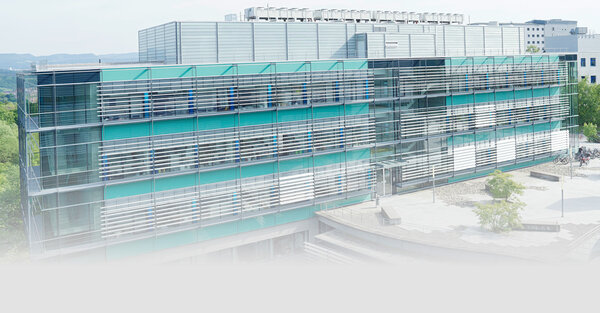

General information
The Hertie Institute for Clinical Brain Research (HIH) and the Clinic of Neurology at the University Hospital Tübingen run the “Hertie Center of Neurology”. Founded in 2001, the center owes its existence to an agreement between several entities: the non-profit Hertie Foundation, the State of Baden-Württemberg, the Medical Faculty of the University of Tübingen, and the University Hospital of Tübingen. The underlying bundling of public resources and private funds is unique in Germany.
The center’s role comprises patient care provided by the Clinic of Neurology as well as scientific research carried out by neuroscientists working at the HIH. This structural crosslink between the HIH and the Clinic of Neurology creates a multifunctional facility that is likewise capable of carrying out clinical brain research, medical attention, as well as scientific training. The close connection between excellent research and clinical care makes the HIH unique among all institutions in brain research.
Since its foundation, the Hertie Foundation has supported the HIH with almost 60 million euros. The funds also serve a reform project: here, the usual hierarchical and particularistic structure of isolated departments has been replaced by an interdisciplinary organizational structure that bundles the resources. The allocation of funds between the different research areas is flexible. A particular concern is the promotion of young scientists: they are provided with the opportunity of establishing their own independent research group early on and are allowed a performance-related salary.
The HIH closely collaborates with other institutions and research groups in Tübingen. Since its foundation by the federal and state government in 2008, the HIH is part of the excellence cluster “Werner Reichardt Centre for Integrative Neuroscience” (CIN) and successfully contributes to its interdisciplinary concept. Furthermore, there is a close cooperation between the HIH and the Tübingen partner location of the German Center of Neurodegenerative Diseases (DZNE), which was founded in Bonn in June 2009. Using the latest technology and ressources, this collaboration aims at developing new strategies for the diagnosis, prevention and treatment of neurodegenerative diseases in the aging human brain, considering particularly Parkinson’s and Alzheimer’s disease.
At present, the HIH is home to 24 professors, about 400 members and more than 30 research groups. Together they ensure the smooth running of clinical research, care and educational training.
Key research areas
The Hertie Institute for Clinical Brain Research currently comprises the following 7 departments, of which the first four are involved in inpatient clinical care:
- Neurology with Neurovascular Medicine (Head: Prof. Dr. Ulf Ziemann)
- Neurology and Epileptology (Head: Prof. Dr. Holger Lerche)
- Neurodegenerative Diseases (Head: Prof. Dr. Thomas Gasser)
- Neurology and Interdisciplinary Neuro-Oncology (Head: Prof. Dr. Dr. Ghazaleh Tabatabai)
- Neural Dynamics and Magnetoencephalography (Director: Prof. Dr. Markus Siegel)
- Cellular Neurology (Director: Prof. Dr. Mathias Jucker)
- N3: Neurorehabilitation / Neuroprosthetics / Neurotechnology (Director: Prof. Dr. Martin Giese)
The Department of Neurology with Neurovascular Medicine has the main focuses in neurovascular medicine (vessel diseases of the brain, cerebral stroke), neuro-immunology (e.g. multiple sclerosis) and neuro-intensive medicine. The department consists of a certified stroke unit, a normal ward specialized on neuro-oncology and neuro-immunology, and a planned neuro-intensive care unit for diagnosis and treatment of these patient groups. In addition, specialized outpatient clinics exist for all of these indications. The main research areas focus on neuroprotection (hypothermia, hyperoxygenation) in acute stroke, reorganization of brain networks after stroke by non-invasive brain stimulation to enhance motor and language rehabilitation, and therapy-relevant research in brain tumors (tumor initiation and microenvironment, viral and cell-based therapies).
The Department of Neurology and Epileptology has a focus on epilepsy and other paroxysmal neurological disorders. In these diseases, the excitability of nerve cells temporarily changes either due to genetic or acquired defects. This results in neurological disorders that may occur suddenly, last for seconds to hours (or sometimes days) and disappear when the malfunction is appropiately compensated. Patients with such disorders often show perfectly normal behavior between attacks. The molecular and cellular research of the department focuses on the genetic factors and mechanisms of paroxysmal disorders such as epilepsy. The modification of ion channels take on an important role in this process, which makes them an interesting target for treatment. In the clinical research of the department, there is one major focus on brain imaging in paroxysmal disorders.
The Department of Neurodegenerative Diseases treats in-patients on a ward of about 20 beds and in several out-patient clinics. The clinical focus lies on neurodegenerative diseases such as Parkinson’s disease, the ataxias, spastic paraplegias, and dementias. In theses disorders, control over bodily functions are weakened or lost due to the progressive demise of neurons in the brain. Another clinical focus is on movement disorders such as dystonia and tremor syndromes. Scientists of the department aim to track down the genetic factors responsible for the development and progression of neurodegenerative diseases and movement disorders. A further goal is to reveal the molecular mechanisms leading to these diseases. Searching for genetic causes at the HIH has the aim to develop and clinically test new treatment strategies.
The Department of Neurology and Interdisciplinary Neuro-oncology (Director: Prof. Ghazaleh Tabatabai) is a department covering both inpatient and outpatient clinical care. The scientific focus includes the entire spectrum of neuro-oncological diseaes and thus builds a bridge between the priority research foci oncology/immunology and neurosciences of the Medical Faculty Tübingen. The spectrum includes primary and metastatic tumors in the nervous system as well as neurological side effects of tumor therapies.
The goal of the Department of Neural Dynamics and Magnetoencephalography, founded in 2020, is to investigate how cognition and behavior emerges from dynamic interactions across widely distributed neuronal ensembles. How do sophisticated cognitive processes such as perception, decision-making, and motor behavior emerge from dynamic interactions across the brain? Which neural mechanisms coordinate these interactions, how are they dynamically regulated in a goal-directed fashion, and how are these interactions disturbed in the diseased brain? To address these questions, they apply an interdisciplinary multi-scale approach and link large-scale population measures of neuronal activity to circuit and cellular-level mechanisms. They combine human magnetoencephalography (MEG) and electroencephalography (EEG), animal electrophysiology, psychophysics and sophisticated analytical techniques.
The focus of the Department of Cellular Neurology lies on cellular and molecular mechanisms in the aging brain and age-related neurodegenerative diseases. Special emphasis is placed on Alzheimer's disease, the most common and severe form of senile dementia. In Germany alone, more than one million people suffer from this disease. The department has made groundbreaking discoveries in the fundamental mechanisms underlying neurodegenerative diseases, such as the role of self-propagating pathogenic protein aggregates in Alzheimer’s disease and other disorders of the aging brain. Noteworthy are also the efforts of the department to translate fundamental research into clinical studies. To foster this translation the department has partnered with the University Clinic of Psychiatry to establish the Section for Dementia Research with its Memory Clinic.
Bridging clinical brain research with cutting edge technological approaches, the Hertie Institute has founded the new Department N3 “Neurorehabilitation / Neuroprosthetics / Neurotechnology”, which applies cutting edge methods from AI, physical intelligence, and physical, neural and behavioral modeling to problems in clinical brain science. Exploiting profound expertise in systems neuroscience, it establishes novel approaches for the analysis and control of neural and behavioral processes with relevance for brain diseases. The Department N3 has close interactions with the other departments of the HIH, and with the University Clinic Tübingen (UKT), translating fundamental research and technical innovations into clinical applications. Close connections with the CyberValley and the University of Stuttgart, and the interuniversity center Bionic Intelligence Tübingen-Stuttgart (BITS) makes the department part of the innovation area for AI and physical intelligence in Tübingen-Stuttgart. The department collaborates closely with the Max Planck Institutes for Intelligent Systems and Biological Cybernetics.







